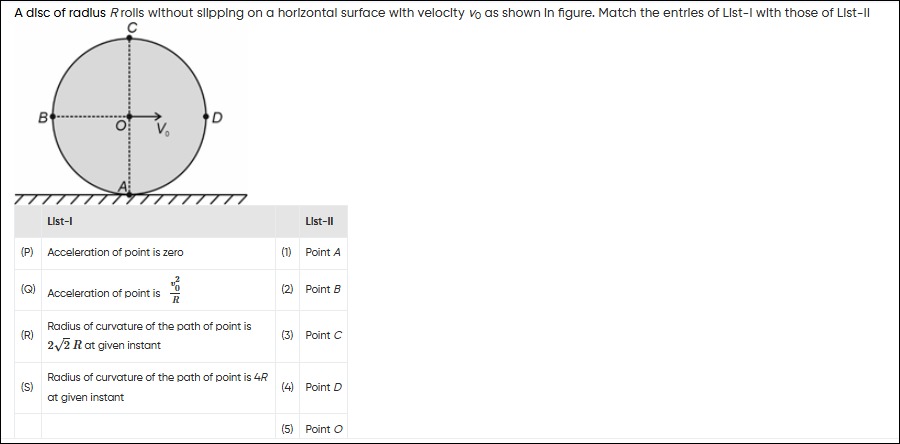Question
Question: A disc of radius $R$ rolls without slipping on a horizontal surface with velocity $v_0$ as shown in ...
A disc of radius R rolls without slipping on a horizontal surface with velocity v0 as shown in figure. Match the entries of List-I with those of List-II. [FIGURE]
List-I: (P) Acceleration of point is zero (Q) Acceleration of point is Rv02 (R) Radius of curvature of the path of point is 22R at given instant (S) Radius of curvature of the path of point is 4R at given instant
List-II: (1) Point A (2) Point B (3) Point C (4) Point D (5) Point O

(P)-(5), (Q)-(1), (2), (3), (4), (R)-(2), (4), (S)-(3)
(P)-(5), (Q)-(1), (R)-(2), (S)-(3)
(P)-(1), (Q)-(5), (R)-(2), (S)-(3)
(P)-(5), (Q)-(1), (2), (3), (4), (R)-(2), (S)-(3)
(P)-(5), (Q)-(1), (2), (3), (4), (R)-(2), (4), (S)-(3)
Solution
For a disc rolling without slipping, the velocity of the center vc=v0 and angular velocity ω=v0/R. Assuming constant v0, angular acceleration α=0.
Velocities:
- Point O (center): vO=v0 (horizontal)
- Point A (bottom): vA=0
- Point B (left): vB=v02+(−v0)2=2v0
- Point C (top): vC=v0+ωR=v0+v0=2v0 (horizontal)
- Point D (right): vD=v02+v02=2v0
Accelerations: The acceleration of any point P on the rim relative to the center is centripetal: aP/O=ω2R=(v0/R)2R=v02/R. The acceleration of the center is zero.
- Point O: aO=0 (constant velocity)
- Point A: aA=aA/O (upwards) =v02/R
- Point B: aB=aB/O (rightwards) =v02/R
- Point C: aC=aC/O (downwards) =v02/R
- Point D: aD=aD/O (leftwards) =v02/R
Radius of Curvature of Cycloid: The path of a point on the rim is a cycloid. The radius of curvature ρ is given by ρ=4Rsin(θ/2), where θ is the angle of rotation from the lowest point.
- Point A (lowest): θ=0⟹ρ=4Rsin(0)=0.
- Point D (rightmost): θ=π/2⟹ρ=4Rsin(π/4)=4R(1/2)=22R.
- Point C (topmost): θ=π⟹ρ=4Rsin(π/2)=4R.
- Point B (leftmost): θ=3π/2⟹ρ=4Rsin(3π/4)=4R(1/2)=22R.
Matching: (P) Acceleration of point is zero: Point O (5). (Q) Acceleration of point is Rv02: Points A (1), B (2), C (3), D (4). (R) Radius of curvature is 22R: Points B (2), D (4). (S) Radius of curvature is 4R: Point C (3).
